I’m excited to have author Jane S. Gabin as our guest blogger today! Jane recently wrote and published her newest book, The Paris Photo, after finding unexplained pictures among her late father’s papers. A native of New York City, Jane earned her Master’s and PhD in English from the University of North Caroline at Chapel Hill. She is an accomplished teacher, educational counselor, lecturer, and most recently, conducting classes on World War II at the Osher Lifelong Learning Institute at Duke University. Jane is a member of the Southern Association for College Admissions Counseling, the Victorian Society of New York, and several branches of Alliance Français. But the most important fact about Jane is that she shares one of our favorite Paris pastimes: sitting in the bistro with a glass of wine or beer and people watching.
S/Sgt. Alfred L. Gabin’s Paris As Told By His Daughter
In Paris, World War II seems like an almost recent event. There are reminders everywhere. You cannot walk a block without seeing a plaque or statue memorializing a person or event. Stops on the Métro remind you as well – Jacques Bonsergent, Colonel Fabien, Guy Môquet.
On this trip to Paris, though, I decide to concentrate on the part of the city my father – who was stationed there in 1944-45 – knew best: the area around Gare Montparnasse. His unit arrived shortly after the Liberation and set up a military postal office in the space under the road leading up to the Gare.
(Rue de l’Arrivee, Gare Montparnasse US Army postal station, 1944; photo by S/Sgt Alfred L. Gabin)
There, between the Rue de l’Arrivee and the Rue du Depart, they prepared incoming letters and parcels for the troops and censored the post. I know the men had free time because I saw from my dad’s photos that they explored the city, had drinks at the many cafes along the Boulevard Montparnasse, and went to horse races at the track in the Bois de Boulogne.
The Gare Montparnasse has been replaced by a new station, and where my father and many others worked is now an unadorned, monolithic 59-story office block offering an unparalleled view of the city. This compensates for its existence. Completed in 1973, the Tour Montparnasse rapidly inspired the passing of legislation limiting the height of any new building in Paris. But it does provide a good vantage point from which to view the area.
The combination of broad Haussmanian boulevards and short neighborhood streets meant that my father was surrounded by an area inviting him to explore. The wide Boulevard du Montparnasse stretched directly in front of where he worked, an important boundary; on the other side was the 6thArrondissement, with the Rue de Rennes running straight ahead down to the church of Saint-Germaine-des-Pres. The basic view has not changed in the intervening 75 years.
The first photo, taken by my father, shows the Boulevard du Montparnasse on VE Day, May 8, 1945.
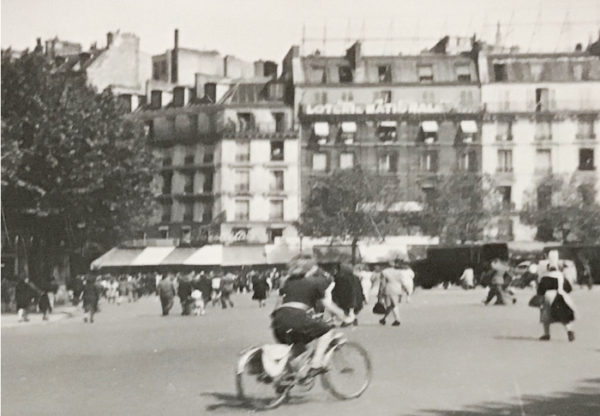 (Boulevard du Montparnasse, 1945; photo by S/Sgt Alfred L. Gabin)
(Boulevard du Montparnasse, 1945; photo by S/Sgt Alfred L. Gabin)
There is no vehicular traffic other than a military truck. Everyone is on foot except for the bicyclist in the foreground. In contrast, the picture I took is evidence of a very crowded traffic scene – wheels everywhere, cars, buses, bicycles, scooters. Pedestrians need clearly marked paths in order to cross safely.
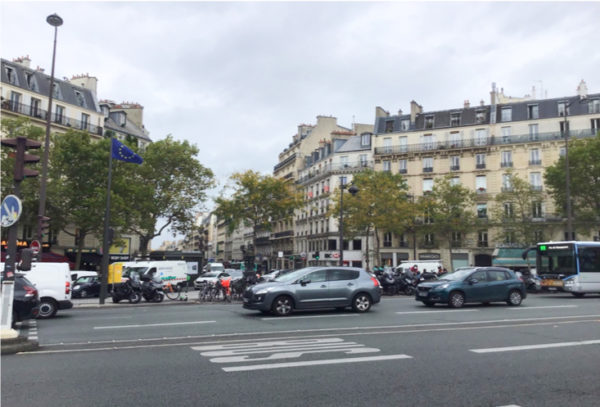 (same place, September 2019; photo by Jane S. Gabin)
(same place, September 2019; photo by Jane S. Gabin)
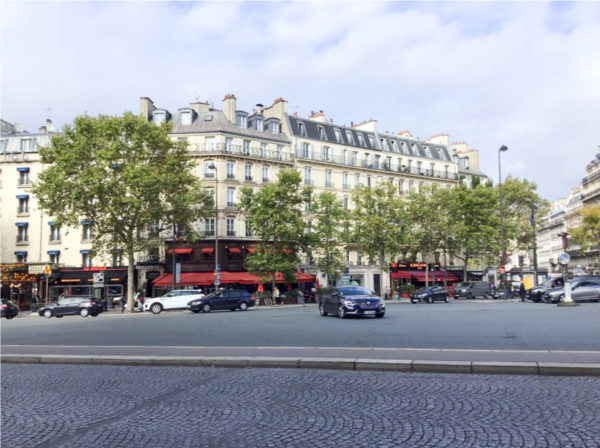 (Boulevard du Montparnasse, September 2019; photo by Jane S. Gabin)
(Boulevard du Montparnasse, September 2019; photo by Jane S. Gabin)
I decide to take a break at one of the local cafes. This one, the Café du Montparnasse, has been there for a century, and there is a good chance that my father, too, stopped in for a drink after a long day of checking the mail. I sit at an upstairs window for an hour, watching people hurrying below, or relaxing at sidewalk tables. I wonder if my father noticed the Wallace fountain close by. 
(View from Floor 2, Café du Montparnasse; photo by Jane S. Gabin)
The next day, I meet a friend at a restaurant, also over 100 years old, with the most gorgeous Art Nouveau décor. Both of these places were open at the time my father was stationed in Paris, though how much food they had depended on how well they had coped with years of rationed supplies.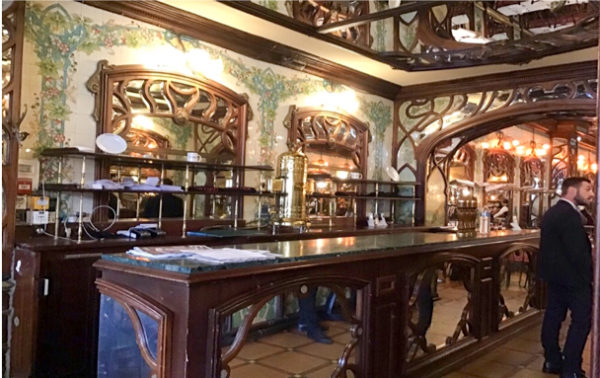
(Bar, Bouillon Chartier, 59 Boulevard du Montparnasse, September 2019; photo by Jane S. Gabin)
There are many other buildings in the area which have not changed much over the decades. One photo taken by my father shows a building festooned with banners and flags of the liberators, with cheering residents at the windows.
 (Rue de l’Arrivee, 1944; photo by S/Sgt Alfred L. Gabin)
(Rue de l’Arrivee, 1944; photo by S/Sgt Alfred L. Gabin)
And there it is, on the Rue de Arrivee, minus the flags and spectators:
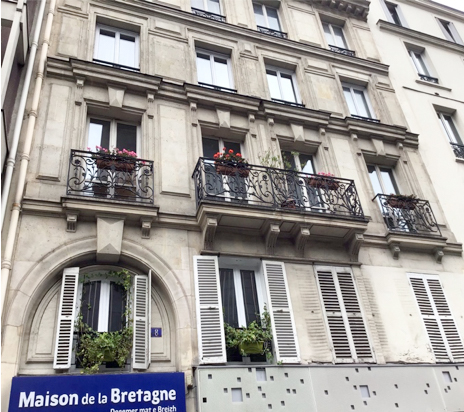 (Rue de l’Arrivee, September 2019; photo by Jane S. Gabin)
(Rue de l’Arrivee, September 2019; photo by Jane S. Gabin)
This year marks the 75thanniversary of the Liberation of Paris, and there have been celebrations, the opening of a new museum, and the issuing of special commemorative postage stamps: 
(Bureau de Poste, 2019; photo by Jane S. Gabin)
And yet there is also a dark undercurrent. Many of the French collaborated, and collaborated knowingly and willingly, with the Nazi government. Yes, there was a brave Resistance. And the invaders were eventually driven out. But they remained in power for four long years, and during that time the French Army was held captive, France was stripped of resources, and thousands of people were arrested, tortured, and murdered.
The special focus of the round-ups, which resulted in deportation, was the Jewish population. Although three-quarters of the Jews living in France were able to flee or hide, 76,000 were deported and killed. That included 11,000 children, some of them just babies. There are many plaques memorializing the murdered children all over Paris, particularly in front of schools. But the dates on these are from the very late 1990s and the early 2000s. There is generally a 50-year gap between them and other war memorials.
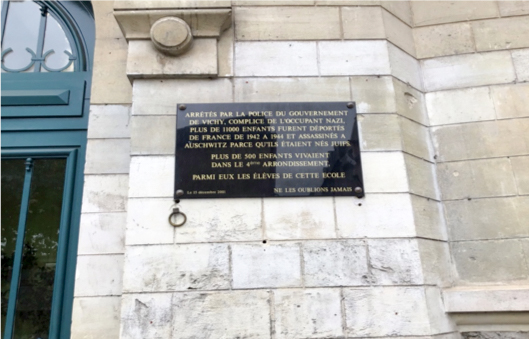

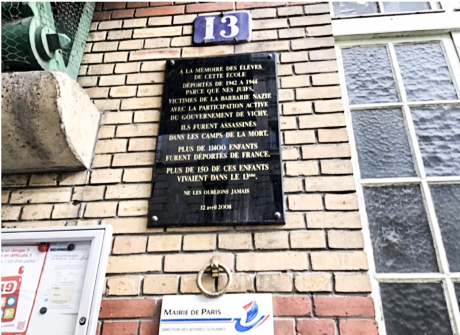 (Plaques in front of several Paris schools, 2018-2019; photos by Jane S. Gabin)
(Plaques in front of several Paris schools, 2018-2019; photos by Jane S. Gabin)
Why is this so? This was all brought up again recently, due to the death in September of Jacques Chirac. Chirac, who led France from 1995 to 2007, was the first French president to acknowledge the active part of the French, in the form of the collaborationist Vichy government, in the deportation of Jews to the extermination camps. Previously, the participation of the French was sidestepped by blaming the Nazis only. This major declaration, made in 1995, is one of the things for which Chirac is most remembered.
The knowledge of this collaboration is the only shadow over my recent trip to Paris. It made me think of all the turmoil, the secret discussions, the soul-searching and the terror that went on behind the placid facades of the buildings. I am brought into the noisy present by the fact that today’s Parisians protest every weekend! Announcements of the next “manif,” or demonstration, are pasted on walls or in shop windows. No passive victims, the French! Social injustice, climate destruction, immigration policies – opinions are public and loud. Good for them!
Stew Always Has The Last Word
I hope you enjoyed Jane’s story as much as I did. As you just read, her father was part of the military postal services and I mentioned to her that we recently posted a blog, The Ten Percenters (read here), which followed the first and only all-black female division sent to Europe for the purpose of clearing six months of backlogged mail. Jane mentions several issues we’ve written about in the past and I hope you’ll explore those blogs to enhance your knowledge [e.g., Wallace Fountains (read here), The Roundup and Cycling Arena (read here)].
✭ ✭ ✭ Learn More About Historic Paris and Jane S. Gabin ✭ ✭ ✭
Cain, Georges. Translated by Alfred Allinson. Walks in Paris. New York: The MacMillan Company, 1909.
Gabin, Jane S. The Paris Photo. Chapel Hill: Wisdom House Books, 2018.
Gabin, Jane S. A Living Minstrelsy: The Poetry and Music of Sidney Lanier. Macon: Mercer University Press, 1985.
Gabin, Jane S. American Women in Gilded Age London: Expatriates Rediscovered. Gainesville: The University Press of Florida, 2006.
Pitt, Leonard. Walks Through Lost Paris: A Journey into the Heart of Historic Paris. Berkeley: Counterpoint Press, 2006.
Pitt, Leonard. Paris: A Journey Through Time. Berkeley: Counterpoint Press, 2010.
Oh, and don’t forget about my books. Also, M. Georges Cain, author of Walks in Paris, was the curator of the Musée Carnavalet, my favorite Paris museum.
What’s New With Sandy and Stew?
Training a beagle puppy, creating and presenting new and interesting lectures, and publishing a bi-weekly blog seem to take up most of our time. It is a lot of fun but it’s difficult finding the time to get the newest book, Where Did They Put the Gestapo Headquarters?, finished. It’s a good thing we have a lot of upcoming cruises with many sea days.
Someone Is Commenting On Our Blogs
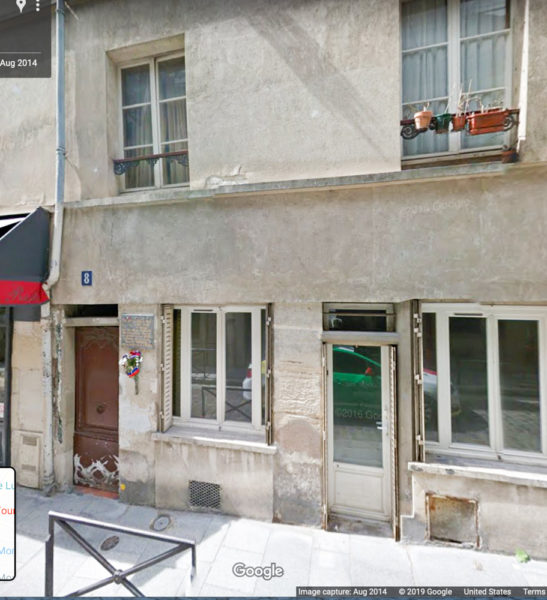
I appreciated Alain Q. from the U.K. reaching out to us the other day in regard to our blog, The Sussex Plan and a Very Brave Woman (read here). Alain wanted us to know that he lived at 8, rue Tournefort between 1950 and 1961. He goes on to say that everyone knew Andrée Goubillon but no one seemed to be aware of her past and involvement with the French Resistance. Just another example of how many brave people tend not to seek recognition or accolades for their accomplishments. The war was the past and they only looked forward. If there is a topic you’d like to see a blog written about, please don’t hesitate to contact me. I love hearing from you so keep those comments coming.
Why Would You Want To Buy Our “Walks Through History” Books?
Simple.
You like to travel and experience history and historical events. You like to see original buildings that had a significant impact on the people and events of the history you’re engaged with. You want to know the stories behind the brick and mortar in front of you.
The walking tour books are meticulously researched so you can go directly to those sites and learn about the building’s history as well as an introduction to some of the more interesting people associated with it.
We Need Your Help
Please tell your friends about our blog site and encourage them to visit and subscribe. Sandy and I are trying to increase our audience and we need your help through your friends and social media followers.
Thank You
Sandy and I appreciate you visiting with us. We have some exciting things on the horizon and we’ll keep you updated as we go along.
Share This:
Follow Stew:
Find Stew’s books on Amazon and iBooks.
Please note that we do not and will not take compensation from individuals or companies mentioned or promoted in the blogs.
 Walks Through History
Walks Through History
Copyright ©2019 Stew Ross

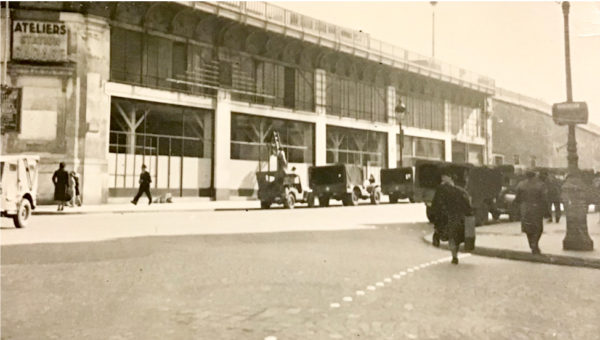

I read every email and blog post you send with great interest. There is always something new to learn about these topics. Those who can tell the stories are quickly dying. I had a cousin who was hidden in Paris from the Germans. Her mother was my grandmother’s sister who did not live through the war. Only recently did I learn from another cousin that Renee’s mother fought in the Resistance and was murdered by the Germans. My grandmother came to the US with her father just after the Revolution in Russia. They lived in Odessa and I cannot find the one critical part of the story. Did she choose to go to Paris or was that the only option that appeared safe when she left Odessa. By sheer fate my grandmother and her father were lucky enough to come here. Or was it “fate?” Luck or intentional choices to come to America or France? Some of this informs us of the difficulty we have today with both political parties in the US. The GOP made that invite to Netanyahu to speak before Congress setting in motion a Republican expectation of Jewish support when Trump later came along. Democrats are leaning in the opposite direction. Most Jews I know do not support many things Israel does but we also know the world is increasingly hostile and see Israel as the last refuge.
I still don’t know much about the story of my grandmother’s family. There were other brothers who came to the US earlier and were very successful attorneys in New York. I could not find the name in any records because as I just recently learned it was changed at Ellis Island. There is much more. The information is out there but gets difficult to find. Ancestry.com is ok to deposit info but I’ve found little info there.
I look forward to your blog always.
Hi Stephen. Thanks for sharing your family’s history during the Occupation. I know it can be frustrating trying to piece together events which encompassed your family. Interesting about Ellis Island but I have a suspicion this was a common occurrence. Thank you for your kind words about our blogs. Don’t ever hesitate to reach out to us in the future and good luck putting the family history puzzle together. STEW